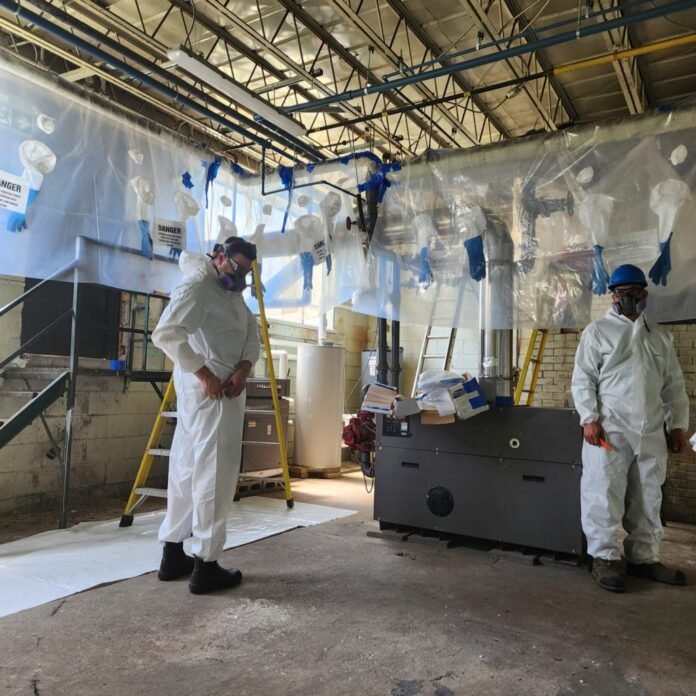Getting rid of old, unsafe building materials can be tricky. Many homes and buildings-built years ago still have dangerous stuff hidden inside. One of those is what people call asbestos removal services. This work is important because harmful dust can cause serious sickness if people breathe it in. Whether it’s your home or workplace, taking steps to clean up the area the right way keeps everyone protected. In this article, you’ll learn about how to spot these materials, how they are removed, and who can help with it. Knowing what to expect can make the whole process feel much easier and safer.
Where These Materials Are Usually Found
Old buildings may hide dangerous fibers in many places. Knowing where to look can help people stay away from trouble. These fibers were used a lot in the past because they were cheap and kept heat from spreading.
Here are common places where they might be found:
- Roofs and ceiling tiles: Found in older houses, these are areas where people often overlook problems.
- Pipes and boiler rooms: Wrapped in insulation, they keep heat in and can contain harmful fibers.
- Floors: Vinyl tiles in kitchens or basements may have stuck beneath the surface.
- Walls and paint: older wall finishes, and joint compounds might be hiding underneath.
- Fireproofing: Office buildings or factories may have sprayed on material to block fire that contains it.
These are just a few places. When people move into older spaces, a proper check can help spot problems early.
How Professionals Make Spaces Safer
When there’s a problem, trained crews handle the job with care. This is not like cleaning dust. It involves steps that protect both the workers and the nearby people.
The process usually goes like this:
- Check the space: A team comes in and checks the site for signs of danger.
- Set up safety barriers: Plastic sheets and air machines are used to keep dust from spreading.
- Wet and remove material: They spray water to stop particles from flying in the air.
- Seal and pack it up: Removed parts go into sealed bags and are clearly marked.
- Test the air: After the work is done, someone checks the air to be sure it’s clean.
All these steps matter because even a little bit of this dust can cause harm.
Different Work Levels Based on Danger
Not all cleanup jobs are the same. The work depends on how much of the harmful fiber is in space and whether it is easy to breathe in.
Here are the common levels:
- Low-risk jobs: Like removing tiles or materials that don’t break easily. Workers wear simple gear.
- Middle-level jobs: These need more care. Gloves, masks, and some extra steps are taken.
- High-risk areas: Where sprayed-on coatings or soft layers exist, more tools and strict safety rules are needed.
Choosing the right way to handle the job helps stop danger before it spreads.
Important Certifications and Training
Not everyone is allowed to do this type of cleanup. There are rules about who can handle this work. Workers must take special classes and follow safety laws.
Here’s what certified workers often have:
- Special classroom training: They learn how to stay safe and how to protect others.
- Real practice: They must show they can do the job in real-world situations.
- Ongoing learning: Rules change, so they need to keep up to date.
- Insurance coverage: They have safety cover if something goes wrong.
This way, people hiring the service can feel more at ease.
Steps That Keep Everyone Protected
A lot of care goes into keeping families, workers, and neighbors safe. It’s more than just taking away old tiles. Here are some key safety steps:
- Closing off work zones: This stops fibers from reaching other areas.
- Air filters: Machines suck in the air and clean it before it spreads.
- Protective gear: Workers wear suits, masks, and gloves.
- Wet work: Keeping things damp lowers dust in the air.
- Shower and change areas: After work, workers clean up before leaving.
Doing each of these helps keep the whole area safer.
Places Where This Work Is Most Needed
This problem isn’t only at home. Many large spaces need help, too. Here’s where cleanup often happens:
- Schools and daycares: These must be clean because kids spend hours there.
- Factories and plants: Older workplaces often have insulation or fireproof coatings.
- Offices: Ceiling tiles or floors in older buildings may be unsafe.
- Hospitals: Clean air is very important where people get treatment.
- Houses from the 1960s to 1980s: Many still have hidden harmful materials.
These areas all need extra care and proper checking.
Trained Help You Can Count On
People doing this job must be skilled, but they must also follow strict laws. They need the right training and paperwork. This includes things like:
- Safety permits: Required to start any work.
- Project plan: A step-by-step list of what they will do.
- Clear signs: So, no one walks into danger by accident.
- Waste tracking: All the removed stuff must be taken to safe disposal places.
Without these, the job is not legal, and it could be dangerous.
Helping You Stay Safe in Your Own Space
Learning about asbestos removal services is important when you’re living in or working around old buildings. The fibers in older homes or offices are not something to ignore. Getting help from trained workers means you’re doing what you can to make your space safe again. All the steps taken—checking, cleaning, sealing, and testing—are designed to protect everyone. It’s not just about getting rid of stuff; it’s about doing it the right way.
Need help with a clean and safe space? Talk to the experts at MSN Enviornmental today.


